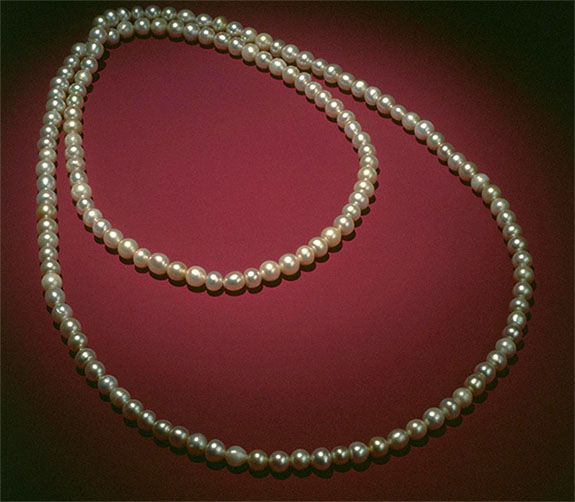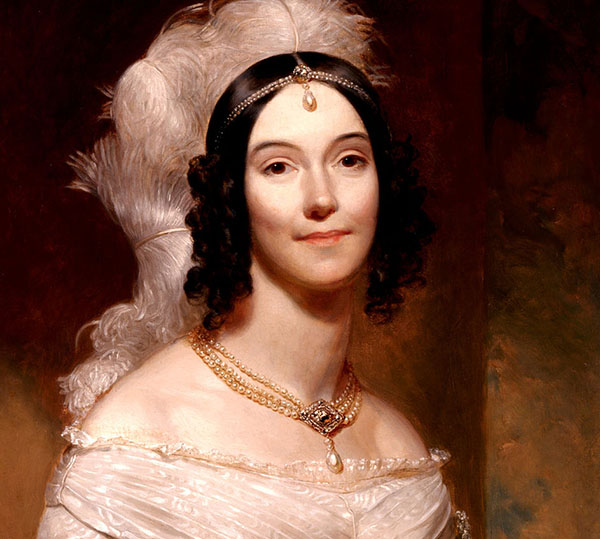June’s Birthstone: These Pearls Were a 1840 Presidential Gift From the Imam of Muscat
Back in April 1840, the ship Sultanee arrived in New York Harbor loaded with exotic gifts for President Martin Van Buren. The valuable offerings included two magnificent Arabian horses, a case of rose oil, five demijohns of rose water, four Cashmere shawls, ivory, wild animal skins, Arabian dates, a bale of Persian rugs, a gold-mounted sword and a long string of 148 natural pearls sourced in the Persian Gulf.

The US had recently signed a Treaty of Friendship and Commerce with the Sultanate of Oman, and the Imam of Muscat's generosity was a way for him to curry favor with Van Buren. Oman had always been fiercely independent and feared the encroaching British Empire.
When the lavish gifts had arrived in the US, the Congress debated whether or not Van Buren could accept them at all. The Constitution generally forbids it, so the eventual compromise was that he could accept them — not as a private citizen, but in his official government role.
The cache of natural pearls was fashioned into a luxurious necklace and worn by Van Buren's 22-year-old daughter-in-law, Sarah Angelica Van Buren, who was had been the acting First Lady because the president's wife had passed away in 1819 and he never remarried.
When the incumbent lost his bid for a second term in late 1840, he deposited the pearl necklace at the National Institute Gallery in the US Patent Office.
According to the Smithsonian, about a year later, on December 20, 1841, a thief broke into the “treasure room” at the National Institute Gallery and stole, among other things, the necklace made from the pearls given by the Imam.
The necklace was recovered, but eventually the Patent Commissioner sealed all the valuables in a metal box and deposited it in the U.S. Treasury.
The items were finally transferred to the Smithsonian in the 1880s. Even then, a thief armed with a Bowie knife and chloroform made a failed attempt to overcome a Smithsonian watchman to steal the valuables.
Today, the necklace is part of the historic First Ladies Collection at the Smithsonian's National Museum of American History. With more than 1,000 objects, the collection documents the lives and contributions of America’s first ladies (and acting first ladies).

In her official portrait, Sarah Angelica Van Buren is wearing pearls around her neck and on her head. The pearls in the portrait don't appear to match the ones gifted by the Imam.
Natural pearls are among the rarest of all gems. In fact, experts believe the odds of opening a random oyster in the wild and finding a natural saltwater pearl is 1 in 100,000. What’s more, if someone was lucky enough to amass a small collection of natural pearls, there’s hardly a chance that they’d match in terms of size, shape, color and luster. This is why the round and near-round pearls gifted by the Imam more than 180 years ago are so special.
June’s official gemstone — the pearl — is unique among all gem types because it is the only one formed entirely within a living creature. Natural pearls occur when an irritant enters the oyster’s shell. To protect itself from the foreign body, the mollusk secretes layers of nacre, which, over time, become a lustrous pearl. To form a cultured pearl, a shell bead is surgically implanted into the mollusk to induce nacre production.
Credits: Natural pearls by NMNH Photo Services. Portrait of Angelica Van Buren by Henry Inman, Public domain, via Wikimedia Commons.

The US had recently signed a Treaty of Friendship and Commerce with the Sultanate of Oman, and the Imam of Muscat's generosity was a way for him to curry favor with Van Buren. Oman had always been fiercely independent and feared the encroaching British Empire.
When the lavish gifts had arrived in the US, the Congress debated whether or not Van Buren could accept them at all. The Constitution generally forbids it, so the eventual compromise was that he could accept them — not as a private citizen, but in his official government role.
The cache of natural pearls was fashioned into a luxurious necklace and worn by Van Buren's 22-year-old daughter-in-law, Sarah Angelica Van Buren, who was had been the acting First Lady because the president's wife had passed away in 1819 and he never remarried.
When the incumbent lost his bid for a second term in late 1840, he deposited the pearl necklace at the National Institute Gallery in the US Patent Office.
According to the Smithsonian, about a year later, on December 20, 1841, a thief broke into the “treasure room” at the National Institute Gallery and stole, among other things, the necklace made from the pearls given by the Imam.
The necklace was recovered, but eventually the Patent Commissioner sealed all the valuables in a metal box and deposited it in the U.S. Treasury.
The items were finally transferred to the Smithsonian in the 1880s. Even then, a thief armed with a Bowie knife and chloroform made a failed attempt to overcome a Smithsonian watchman to steal the valuables.
Today, the necklace is part of the historic First Ladies Collection at the Smithsonian's National Museum of American History. With more than 1,000 objects, the collection documents the lives and contributions of America’s first ladies (and acting first ladies).

In her official portrait, Sarah Angelica Van Buren is wearing pearls around her neck and on her head. The pearls in the portrait don't appear to match the ones gifted by the Imam.
Natural pearls are among the rarest of all gems. In fact, experts believe the odds of opening a random oyster in the wild and finding a natural saltwater pearl is 1 in 100,000. What’s more, if someone was lucky enough to amass a small collection of natural pearls, there’s hardly a chance that they’d match in terms of size, shape, color and luster. This is why the round and near-round pearls gifted by the Imam more than 180 years ago are so special.
June’s official gemstone — the pearl — is unique among all gem types because it is the only one formed entirely within a living creature. Natural pearls occur when an irritant enters the oyster’s shell. To protect itself from the foreign body, the mollusk secretes layers of nacre, which, over time, become a lustrous pearl. To form a cultured pearl, a shell bead is surgically implanted into the mollusk to induce nacre production.
Credits: Natural pearls by NMNH Photo Services. Portrait of Angelica Van Buren by Henry Inman, Public domain, via Wikimedia Commons.

